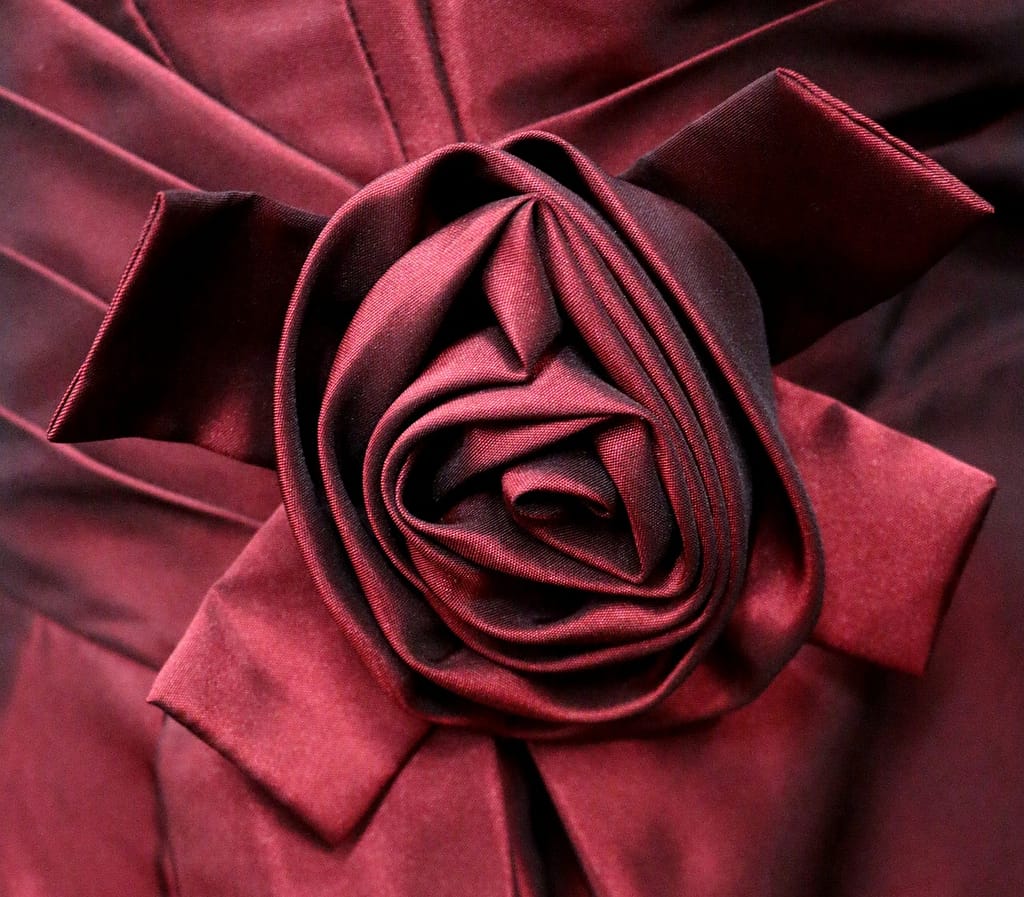Home » Satin fabric
The Grandeur of Satin: More than just a Fabric
When it comes to luxurious fabrics, satin fabric is undoubtedly a front-runner. Known for its smooth and shiny surface, satin fabric exudes opulence and elegance like no other. But there is more to satin fabric than just its luxurious appearance. In this blog post, we will delve into the grandeur of satin and explore its fascinating history, cultural significance, modern applications, care tips, and even its role in interior design. So, let’s unravel the secrets of satin fabric and discover why it is more than just a fabric.

The Lustrous History of Satin Fabric
Satin’s origins are steeped in history, tracing back to the medieval period when it was first woven from pure silk, making it the prerogative of monarchs and the aristocracy. This opulent material owes its name to the Chinese port city of Quanzhou, in the Fujian province, known in the medieval Islamic world as Zayton. Merchants travelling along the Silk Road introduced this exquisite fabric to the Middle East and Europe, where it was initially called “samite” before evolving into the satin we know today. The intricate weaving process, which allowed fewer fibres to be visible on the surface, thereby creating its hallmark glossy finish, was a closely guarded secret. This exclusivity further cemented satin’s status as a luxury textile.
As centuries passed, advancements in textile production enabled the creation of satin from synthetic fibres, significantly reducing costs and making it more accessible. Yet, despite these changes, the allure of satin has remained undiminished. Its journey from the regal courts of ancient dynasties to contemporary fashion runways is a testament to the enduring appeal and timeless elegance of satin fabric. This transformation underscores satin’s adaptability and its unbroken connection to a rich tapestry of cultural heritage, which continues to influence its use and perception in modern times.
Unravelling the Silky Smooth Texture of Satin
The hallmark feature that sets satin apart is its exquisitely smooth and shiny exterior, a product of the unique satin weave technique. In this weaving method, warp yarns are floated over weft yarns, allowing for a greater number of yarns to lie parallel on the surface, thereby giving satin its signature sheen. This intricate weaving not only imparts a visually stunning finish but also renders the fabric supremely soft to the touch. Such a texture ensures that satin drapes elegantly, conforming gracefully to shapes and silhouettes. This tactile pleasure combined with the visual appeal contributes to the fabric’s longstanding association with luxury and comfort. Whether it adorns the wearer as a sumptuous garment or envelops in the form of sumptuous bedding, the smooth texture of satin fabric offers an unmatched sensory experience. Its ability to catch and reflect light beautifully further enhances its aesthetic, making it a favoured choice for those seeking to infuse a sense of lavishness into their attire or home decor. The texture of satin, thus, is not merely a physical attribute but a testament to the fabric’s rich heritage and enduring charm in the realm of textiles.

Satin Fabric Across Cultures: A Symbol of Luxury
Throughout the world, satin fabric has woven its way into the cultural tapestry of numerous societies, each imbuing it with its own set of meanings and values. In the East, satin’s radiant surface has been pivotal in celebratory garments, symbolising joy and prosperity during significant life events such as weddings and landmark festivals. This tradition underscores satin’s role not just as a fabric, but as a harbinger of good fortune and well-being. Similarly, in Western societies, satin’s allure has been perennially recognised by the fashion elite. It serves as a canvas for creativity for designers.
who leverage its luxurious texture and sheen to craft garments and accessories that epitomise glamour and sophistication. Beyond its aesthetic value, satin holds a place of reverence in various cultural rituals and practices, highlighting its versatility and enduring appeal. Its adoption across different societies exemplifies its universal appeal as a luxury textile, transcending mere fashion to become a cultural artefact. This widespread recognition of satin as a luxury symbol demonstrates its unique place in the fabric pantheon, cherished by many for its beauty and the sense of prestige it bestows upon its wearers and beholders alike.
The Versatile Appeal of Satin in Modern Fashion
Satin fabric, with its rich historical legacy, effortlessly adapts to the contours of contemporary fashion. Its inclusion in the latest collections by renowned designers and fashion houses underscores its unbroken relevance in the industry. The fabric’s innate ability to blend with both casual and formal aesthetics makes it an indispensable part of the modern wardrobe. Satin can transform a simple daytime look into a sophisticated ensemble or add a luxurious touch to evening wear with its intrinsic shine and smoothness. The adaptability of satin ensures it can serve as the focal point in a statement outfit or play a supporting role through subtle, elegant accents.

This duality not only highlights satin’s timeless beauty but also its utility in crafting diverse fashion pieces that cater to a variety of tastes and occasions. The incorporation of satin into accessories further demonstrates its versatility, offering a polished finish to everything from handbags to footwear. In the dynamic world of fashion, where trends come and go with the seasons, satin remains a constant, cherished for its luxurious feel and enduring appeal.
Caring for Satin: Tips to Maintain Its Splendour
Maintaining the pristine condition of satin requires a considered approach, due to its delicate nature. It is advisable to wash satin items by hand, employing lukewarm water combined with a gentle detergent to preserve the fabric’s integrity. Machine washing is best avoided to prevent the material from snagging or the colours from fading. Should there be a need to use a washing machine, placing the satin in a mesh laundry bag on a gentle cycle can offer a layer of protection. Excessive exposure to direct sunlight when drying can degrade the quality of the fabric; thus, air-drying in a shaded area is most beneficial. For those inevitable wrinkles, a low-heat iron on the reverse side of the fabric or a steamer can gently smooth out the creases. When storing satin garments, it’s crucial to avoid overcrowding in the wardrobe to prevent wrinkles and to consider using padded hangers to preserve the shape and texture of the fabric. Adhering to these care guidelines will not only extend the life of satin products but also ensure that their luxurious feel and aesthetic appeal remain unaltered, allowing them to continue adding a touch of elegance and sophistication to your collection.
Beyond Fashion: The Uses of Satin in Interior Design
Satin’s influence transcends the realms of fashion, extending its luxurious touch to the sphere of interior design. This versatile fabric imbues any home with a layer of sophistication and refined elegance that few materials can match. Employed in the crafting of sumptuous bedding, satin ensures a lavish sleeping experience, turning the bedroom into a haven of comfort and style. Its application in drapery transforms windows into statement pieces, with the fabric’s natural sheen catching and reflecting light to brighten and enrich the space. Satin also finds its place in upholstery and accent cushions, adding a tactile and visual depth to living areas and lounges. Its unique texture and sheen can break the monotony of matte finishes, providing a subtle yet impactful contrast. Moreover, satin’s use in interior design is not merely about aesthetics; it also brings a sense of tranquillity and warmth to spaces, making it an ideal choice for those looking to create an inviting and luxurious environment. Through its incorporation into various elements of home decor, satin proves its versatility and enduring appeal, offering a timeless option for elevating interiors.

The Future of Satin: Innovations and Sustainability
As we venture into the future, the realm of satin fabric is set to be revolutionised by groundbreaking advances in textile technology. The industry is currently on the cusp of introducing sustainable versions of this beloved material, marking a significant shift towards ethical and green practices. These innovative iterations of satin, crafted from eco-friendly sources and utilising cruelty-free methods, are designed to meet the growing consumer appetite for fashion that marries elegance with environmental responsibility.
The development of these sustainable satins does not compromise on the luxurious feel and aesthetic that satin is renowned for; instead, they offer a guilt-free opulence.
By employing recycled materials and plant-based fibres, manufacturers are able to reduce the environmental footprint of satin production significantly. This approach not only conserves resources but also minimises the harmful impacts of textile manufacturing on the planet.
Further, the industry is exploring new dyeing and finishing processes that are less water-intensive and use non-toxic chemicals, ensuring that the journey of satin from factory to wardrobe is as environmentally friendly as possible. These strides towards sustainability in the satin sector reflect a broader commitment within the fashion industry to embrace eco-conscious practices.
As satin continues to evolve, its future seems poised to be as lustrous as its finish, with sustainability at its core. This shift heralds a new era for satin fabric, promising a continuation of its legacy in a manner that is both innovative and mindful of the planet.